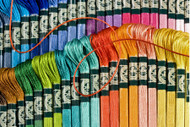Working with Satin Embroidery Floss
Posted by Tracey M. Kramer on 28th Mar 2016

The Allure of Satin Embroidery Floss
Beautiful DMC satin embroidery floss —you’ve seen it.
The allure of their bright colors and incredible shine are electrifying
as they call out to you. DMC satin embroidery floss
is made with rayon. Even the name rayon
makes you think of tensile strength, but looks can be deceiving. While DMC satin floss comes in a variety of
attractive bright colors and has an irresistible sheen, actually stitching
with it can be quite troublesome. The
rayon in this thread does not have tensile strength and is prone to
breakage. For instance, while pulling
the thread through the material, the texture of the material no matter how soft
and giving, sometimes proves to be too rough which causes the satin thread to
shred and fray with each pass through the fabric eventually disintegrating the
thread into a puff of fuzz which probably matches your temperament by now
(after using this thread). And if you happen
to get a knot in your thread, I doubt you will be able to save your thread as
it will virtually be impossible to get the knot out without tearing up the
thread. Because of the softness and
silkiness of the floss, it is very difficult to thread your needle whether the
floss is wet or dry. You will definitely
have to use a threader of some sort, or you’ll be pulling your hair out. As far as variety, the color palette of DMC satin
floss is limited to only 60 colors.
Availability of Satin Embroidery Floss
On a positive note, DMC makes their satin embroidery floss available through many outlets like Amazon, Herrschners, and even has been seen in Walmart Stores. If you plan to use this type of floss, there are things you can do to make your experience more positive. For instance, make your floss lengths shorter. Stitching with long strands causes them to knot up more, and increases the chance of fraying which weakens the floss. Some people have gone as far as spritzing the floss with a little water before working with it, which supposedly reduces the fraying. Whatever decision you make, hopefully you will keep these pros and cons in mind when attempting your next project. Happy Stitching!

